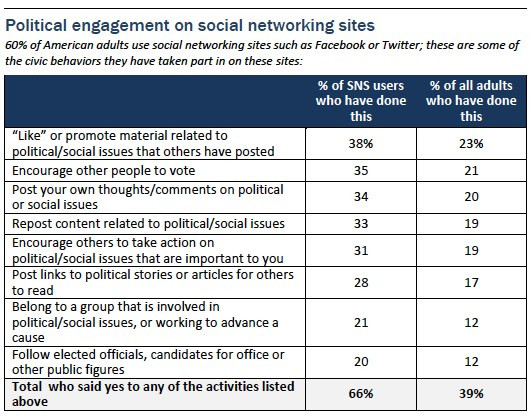Civic Engagement
Civic EngagementThe term "civic engagement" is not commonly used among psychologists, yet the focus on work for the common good is central to most of the divisions of APA. This section demonstrates ways that psychologists support civic engagement and invites the reader to consider other possible examples.Definition of Civic Engagement
Service-learning and civic engagement are not the same thing in the sense that not all service-learning has a civic dimension and not all civic engagement is service-learning. For definition's sake, civic engagement is the broader motif, encompassing service-learning but not limited to it. One useful definition of civic engagement is the following: individual and collective actions designed to identify and address issues of public concern. Civic engagement can take many forms, from individual voluntarism to organizational involvement to electoral participation. It can include efforts to directly address an issue, work with others in a community to solve a problem or interact with the institutions of representative democracy. Civic engagement encompasses a range of specific activities such as working in a soup kitchen, serving on a neighborhood association, writing a letter to an elected official or voting. Indeed, an underlying principal of our approach is that an engaged citizen should have the ability, agency and opportunity to move comfortably among these various types of civic acts.
Source: Michael Delli Carpini, Director, Public Policy, The Pew Charitable Trusts.Resources for Civic Engagement
Civic Engagement Across the Curriculum (2002) is a resource book written by Rick Battistoni and published by the Campus Compact. The book presents frameworks for defining good citizenship and addresses the practical skills of engaged citizenship. The author provides an appendix of assignments and exercises that can be adapted to a variety of courses.
Civic Responsibility and Higher Education (2000) edited by Thomas Ehrlich presents essays from national leaders who have focused on civic responsibility and higher education.
The Indicators of Engagement Project is a grant project to document and disseminate best practices of civic engagement on college campuses.
The Journal for Civic Commitment is focused on providing discussion and practical ideas for connecting service-learning and civic engagement.
Educating Citizens: Preparing America's Undergraduates for Lives of Moral and Civic Responsibility (2003) by Anne Colby, Thomas Ehrlich, Elizabeth Beamont, and Jason Stephens describes how a variety of institutions are effectively preparing socially responsible graduates.
APA Divisions with a Role in Civic Engagement
Civic engagement is at the forefront of many APA initiatives. Psychologists and psychology educators are leading efforts to address serious societal concerns. Their work can be found in many settings addressing a broad cross section of society. Below are some examples of the work conducted through APA, its members and the people who are served.
Division 9 — Society for the Psychological Study of Social Issues (SPSSI) welcomes psychologists and allied social scientists who share a common concern with research on psychological aspects of important social issues and social subjects to bring theory and practice into focus on human problems of the group, the community, and the nation, and the increasingly important problems that have no national boundaries. SPSSI has been represented as a Non-Governmental Organization (NGO) at the United Nations since 1987 and has held consultative status with the UN's Economic and Social Council since 1991.
Division 16 — School Psychology is composed of scientific-practitioner psychologists whose major professional interests lie with children, families, and the schooling process. The Division represents the interests of psychologists engaged in the delivery of comprehensive psychological services to children, adolescents, and families in schools and other applied settings. The Division is dedicated to facilitating the professional practice of school psychology and actively advocates in domains, such as education and health care reform, which have significant implications for the practice of psychology with children.
Division 17 — Counseling Psychology brings together psychologists, students and professional affiliates who are dedicated to promoting education and training, scientific investigation, practice, and diversity and public interest in professional psychology. The division is involved with response to disaster and trauma.
Division 18 — Psychologists in Public Service responds to the needs of the public in areas such as psychological practice, research, training, and policy formation. The Division is comprised of five sections representing a variety of settings: Community and State Hospital Psychologists, Criminal Justice, Police and Public Safety, Program Evaluation, and Veterans Affairs (VA) Psychologists. Federal advocacy is taking place on a number of fronts of interest to public affairs.
Division 27 — Society for Community Research and Action: Division of Community Psychology encourages the development of theory, research, and practice relevant to the reciprocal relationships between individuals and the social system which constitute the community context.
Division 35 — Society for the Psychology of Women provides an organizational base for all feminists, women and men of all national origins, who are interested in teaching, research, or practice in the psychology of women. The division recognizes a diversity of women's experiences which result from a variety of factors, including ethnicity, culture, language, socioeconomic status, age and sexual orientation.
Division 37 — Child, Youth, and Family Services is concerned with professional and scientific issues relative to services and service structures for children and youth. The Division seeks to advance research, education, training, and practice and relate psychological knowledge to other fields such as anthropology, law and pediatrics in such areas as employment, education, recreation and family planning. The division is interested in the areas of child maltreatment.
Division 45 — Society for the Psychological Study of Culture, Ethnicity and Race encourages research on ethnic minority issues and the application of psychological knowledge to ethnic minority issues. The Division promotes public welfare through research and encourages professional relationships among psychologists who share these concerns and interests. Training tapes are available which discuss working with members of diverse communities.
Division 48 — Society for the Study of Peace, Conflict & Violence: Peace Psychology Division works to promote peace in the world at large and within nations, communities, and families. It encourages psychological and multidisciplinary research, education and training on issues concerning peace, nonviolent resolution, reconciliation and the causes, consequences and prevention of violence and destructive conflict. The division has a statement on recent terrorist events.
Division 51 — The Society for the Psychological Study of Men and Masculinities advances knowledge in the new psychology of men through research, education, training, public policy and improved clinical services for men. SPSMM provides a forum for members to discuss the critical issues facing men of all races, classes, ethnicities, sexual orientations and nationalities. Members have conducted research in the area of spousal abuse.
Division 53 — Society of Clinical Child and Adolescent Psychology represents psychologists who are active in teaching, research, clinical services, administration and advocacy in clinical child psychology to the APA and the public. The division provides valuable information concerning talking with children about disasters and trauma.
Division 55 — American Society for the Advancement of Pharmacotherapy (ASAP), Division 55, was created to enhance psychological treatments combined with psychopharmacological medications. It promotes the public interest by working for the establishment of high quality statutory and regulatory standards for psychological care. The Division encourages the collaborative practice of psychological and pharmacological treatments with other health professions. The division has developed a statement on the effectiveness of psychologists prescribing medications.
Source : https://www.apa.org/education/undergrad/civic-engagement
When you subscribe to the blog, we will send you an e-mail when there are new updates on the site so you wouldn't miss them.





